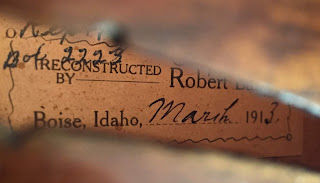This bow came in for a rehair. Not a particularly strong stick, it had a significant warp at the tip end when tensioned. We'll try to compensate for that somewhat in the rehair. It is not a stick that would justify heating and bending. It may not even survive that.
A Chinese bow with a water-buffalo(?) horn frog. Interesting look. Not one I sold, and this is the factory hair, the first rehair for this bow.
Here we are with a rounded leading edge on this block. Not a great sign, showing that they haven't bothered to square up the mortise edges, leaving it as it came away from the router.
On pulling the plug and hair out, here we can see that they didn't even bother cleaning up the edge that is in contact with the hair.
Not a good situation. Seeing more and more of this sort of factory work these days. I suppose they believe they can cover up shoddy work with a fleur-de-lis.
Well, we can't let it go out like that, so, a bit of chisel work to square up the mortise. Then, it can be rehaired -- without resorting to glueing the hair and plug in place, which is the way it presented itself here.
Bow is rehaired, back in the customer's hands. Still a bit of a warp to the stick under tension, but not as bad as it was.





















































